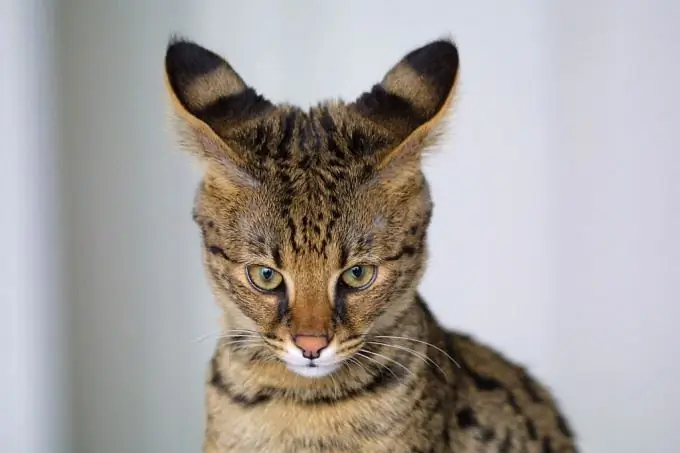- Author Delia Mathews [email protected].
- Public 2023-12-16 00:05.
- Last modified 2025-01-22 15:45.
The Savannah cat breed appeared relatively recently - the first kitten, which became the first representative of the largest domestic cat breed in the world, was born in 1986 in the USA, Pennsylvania, to a Bengal breeder Judy Frank. The kitten's parents were a Siamese cat and a male Serval, a feline predator. Serval was not chosen by chance - these animals are relatively easy to tame and are distinguished by high intelligence. However, keeping them is rather problematic. Savannahs, on the other hand, have retained all the advantages of wild cats, but at the same time they are much easier to get used to the tray, and in general they are much less troublesome.

Appearance
The savannah has a slender flexible body, long legs, a spotted color, like a leopard. The coat is soft, the ears are large, and the eyes have a rather exotic shape. The tail is fluffy, the neck is long, the growth of the representatives of this breed reaches 60 cm at the withers.
Character
Savannahs are very mobile and playful, they inherited from their wild ancestor the ability to jump far and high, as well as a love of water procedures. So if you decide to have such a pet, you shouldn't have any special problems with bathing it. Savannahs are smart, inquisitive and loyal. Many owners of these animals note that in character they are more like dogs than cats.
Serval blood content and cost of cats
The basis for crossing savannahs are domestic cats of Siamese, Bengal, Oriental breeds and Egyptian Mau. Savannas born in different generations are assigned different designations - from F1 to F5. F1 means that the kitten is a direct descendant of a serval and a domestic cat, respectively, F2 is a serval's grandson, F3 is a great-grandson, etc.
The serval blood content in the F1 generation is about 65%, with each successive generation this value decreases down to 5% in F5. Thus, the most expensive savannahs are representatives of the F1 and F2 generations, and their cost varies between 4 and 20 thousand dollars. As for the F3-F5, they can be purchased for $ 1-4 thousand. Males are cheaper than females, since the first four generations of males cannot have offspring and are not suitable for breeding.






